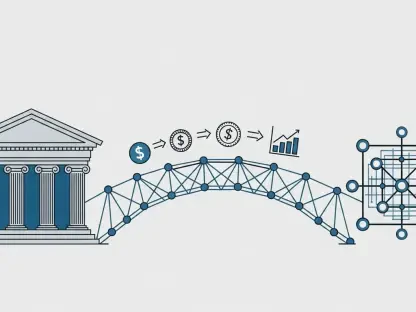As the financial landscape continues to evolve with rapid advancements in technology and policy, few experts are as equipped to guide us through these changes as Kofi Ndaikate. With a deep background in fintech, spanning blockchain, cryptocurrency, regulation, and policy, Kofi offers a unique perspective on the intersection of innovation and financial systems. Today, we dive into the Federal Reserve’s recent announcement to expand the operating days of the Fedwire Funds Service and the National Settlement Service, exploring what this means for the future of payments, the challenges ahead, and the broader implications for businesses and consumers alike.
Can you walk us through what the Fedwire Funds Service and the National Settlement Service are, and why they play such a critical role in the U.S. financial system?
Absolutely. The Fedwire Funds Service is a cornerstone of the U.S. financial infrastructure, handling massive electronic transfers—think up to $10 million per transaction—between financial institutions. It processes around $4.7 trillion in global commerce daily, facilitating everything from business payments to real estate settlements. The National Settlement Service, on the other hand, supports private-sector clearinghouses by providing a centralized platform for settling transactions among participants. Together, these systems ensure that money moves smoothly and securely across the economy, acting as the backbone for wholesale payments and financial stability.
What’s driving the Federal Reserve’s decision to expand the operating days of these services to include Sundays and some holidays?
I believe this move is largely a response to the accelerating pace of digital payments and the growing expectation for real-time financial services. As more transactions shift online and businesses operate across time zones, there’s a clear demand for systems that don’t just shut down on weekends or holidays. This expansion aligns with broader fintech trends, where 24/7 access is becoming the norm, and it aims to keep the U.S. competitive in a global market where other countries are already moving toward constant availability.
How do you think this expansion will benefit consumers and businesses in practical terms?
For businesses, having access to these services on Sundays and holidays means greater flexibility in managing cash flow and executing time-sensitive transactions, especially for industries like retail or logistics that don’t stop on weekends. For consumers, it could translate to faster direct deposits—imagine getting your paycheck on a Sunday instead of waiting until Monday. It also opens the door for more seamless money transfers between accounts during non-traditional hours, which is a game-changer for personal finance in a digital age.
The Fed has indicated this change might not happen until 2028 or later. What do you think is behind this long timeline?
Implementing a change of this magnitude isn’t just flipping a switch. There are significant technical and operational hurdles to overcome, from upgrading legacy systems to ensuring cybersecurity across expanded operating windows. Additionally, coordinating with thousands of financial institutions to align their processes and staffing takes time. There’s also the need for thorough testing to avoid disruptions in such critical systems. I suspect the Fed is being cautious to get it right rather than rush and risk instability.
Some members of Congress have expressed frustration with the delay, pushing for quicker action. How do you view their sense of urgency?
I understand where Congress is coming from. The digital economy is moving fast, and there’s a real need for financial systems to keep up, especially for workers who rely on timely direct deposits or individuals needing to transfer funds outside regular business hours. Their push reflects a broader societal shift toward expecting instant access to money. However, balancing speed with stability is crucial, and I think the Fed’s measured approach might ultimately serve the system better in the long run, even if it feels slow to some.
Smaller banks and credit unions have voiced concerns about the costs of adapting to expanded operating days. How do you see this impacting them?
Smaller institutions are in a tough spot. Expanding operating days means they’ll likely need to invest in technology upgrades to handle transactions during these new windows, not to mention additional staffing costs to monitor and support operations. For many, these expenses could strain already tight budgets, especially compared to larger banks with deeper resources. This could widen the gap between big and small players unless there’s some form of assistance or phased implementation to ease the burden.
Do you think the Fed should step in to support these smaller financial institutions with the transition?
Definitely. The Fed has a responsibility to ensure an equitable financial system, and that includes helping smaller banks and credit unions manage the costs of such changes. This could be through subsidies, technical support, or even staggered implementation timelines that give smaller players more breathing room to adapt. Without support, we risk creating a two-tiered system where only the big institutions can fully participate in the expanded landscape, which isn’t good for competition or consumer choice.
The Fed mentioned they’ll monitor demand before deciding on a potential move to seven days a week. What factors do you think will shape that decision?
Consumer and business demand will be the biggest drivers. If we see a surge in transactions on the newly added days like Sundays, or if there’s consistent feedback from industries needing full-week access, that’ll push the Fed toward a seven-day model. Technological readiness and global trends will also play a role—if other major economies adopt round-the-clock systems, the U.S. will feel pressure to follow suit. Plus, the Fed will likely weigh the costs versus benefits, especially after seeing how the initial expansion pans out.
Looking ahead, what’s your forecast for the future of payment systems in the U.S. with these kinds of changes on the horizon?
I’m optimistic that we’re heading toward a truly always-on financial ecosystem. The expansion of operating days for Fedwire and the National Settlement Service is just the beginning. Over the next decade, I expect we’ll see not only seven-day operations but also a push toward 24-hour availability as digital payments and fintech innovations continue to reshape expectations. The challenge will be ensuring inclusivity—making sure smaller institutions and underserved communities aren’t left behind. If the Fed and industry stakeholders can strike that balance, we’re looking at a payments system that’s faster, more accessible, and more aligned with the realities of a global, digital economy.









